15 Most Sustainable Accessories Brands: The Conscious Consumer’s Guide
Affiliate Disclosure
Hey fellow impactful ninja ?
You may have noticed that Impactful Ninja is all about providing helpful information to make a positive impact on the world and society. And that we love to link back to where we found all the information for each of our posts.
Most of these links are informational-based for you to check out their primary sources with one click.
But some of these links are so-called "affiliate links" to products that we recommend.
Why do we add these product links?
First and foremost, because we believe that they add value to you. For example, when we wrote a post about the environmental impact of long showers, we came across an EPA recommendation to use WaterSense showerheads. So we linked to where you can find them. Or, for many of our posts, we also link to our favorite books on that topic so that you can get a much more holistic overview than one single blog post could provide.
And when there is an affiliate program for these products, we sign up for it. For example, as Amazon Associates, we earn from qualifying purchases.
What do these affiliate links mean for you?
First, and most importantly, we still only recommend products that we believe add value for you.
When you buy something through one of our affiliate links, we may earn a small commission - but at no additional costs to you.
And when you buy something through a link that is not an affiliate link, we won’t receive any commission but we’ll still be happy to have helped you.
What do these affiliate links mean for us?
When we find products that we believe add value to you and the seller has an affiliate program, we sign up for it.
When you buy something through one of our affiliate links, we may earn a small commission (at no extra costs to you).
And at this point in time, all money is reinvested in sharing the most helpful content with you. This includes all operating costs for running this site and the content creation itself.
What does this mean for me personally?
You may have noticed by the way Impactful Ninja is operated that money is not the driving factor behind it. It is a passion project of mine and I love to share helpful information with you to make a positive impact on the world and society. However, it's a project in that I invest a lot of time and also quite some money.
Eventually, my dream is to one day turn this passion project into my full-time job and provide even more helpful information. But that's still a long time to go.
Stay impactful,
Amid growing concerns about the textile industry’s environmental impact, there is pressure to find greener options not only for your clothes but also for your accessories. Unfortunately, fashion greenwashing makes it harder for you and other consumers to figure out which clothing brands offer the most eco-friendly accessories, from belts to clutches. So, we had to ask: Which are the most sustainable accessories brands?
The most sustainable accessories brands are Unbelts, HYER GOODS, BOTTLETOP, and Johnstons of Elgin, which prioritize reclaimed and recycled materials and strive for circularity. In addition, Nisolo and BOTTLETOP reduce carbon emissions, adhere to ethical manufacturing, and give back to communities.
Whether you are searching for a scarf or a hat that compliments your outfit without negatively impacting the soil, the water, the animals, and other people, there is a brand for you. So, let’s keep reading to learn more about the most sustainable accessories brands and how they ensure sustainable, ethical practices.
Here’s How We Selected the 15 Most Sustainable Accessories Brands
Accessories can be among the higher-impact and less sustainable items due to their infrequent use and conventional use of high-impact materials like leather and wool.
“Sustainable: The ability to be maintained at a certain rate or level | Avoidance of the depletion of natural resources in order to maintain an ecological balance”
Oxford Dictionary
The brands on this list were chosen based on their commitment and actions to promote sustainable practices while reducing the environmental impacts of the textile industry.
They are transparent about their materials, processes, and workforce management within their supply chain.
Some brands focus their efforts on reducing waste and optimizing natural resources while others strive to reduce the carbon footprint of their clothes.
All of these brands share the commitment to reshape the textile industry toward a more sustainable and Earth-friendly sector.
These Are the 15 Most Sustainable Accessories Brands
Most Sustainable Accessories Brands
Overall, these accessories brands are sustainable. Yet, they take various approaches to reduce environmental impacts and uphold ethical standards. Let’s dive into each brand and find out more.
Unbelts: Comfortable Belts That Complement Your Outfits and Benefit Textile Workers


“Unbelts are designed to minimize resource extraction and maximize worker benefit along our entire supply chain. Our suppliers pay living wages and maintain stable, long-term teams; they also use recycled input materials to make our components.”
Unbelts
🌎
How do they ensure their sustainability?
Unbelts prioritizes sustainability by minimizing waste and reducing their climate impact.
- Firstly, they take several approaches to waste reduction, including avoiding unnecessary features and excess materials in product design and packaging, using recycled and diverted materials at every possible stage of their supply chain, and offering free repairs to keep belts longer in circulation. Specifically, the Unbelts Intrepid belts are made with 53% recycled polyester and backed with a Lifetime Guarantee, aka free repairs or replacement forever. Additionally, Unbelts Loop upcycled accessories are made with offcuts and imperfect elastic. The brand also uses recycled packaging.
- Secondly, Unbelts manufactures all of their products locally in Canada to reduce the climate impact of long-distance shipping.
🌐
How do they ensure their ethics?
Unbelts traces most of their supply chain and ensures payment of a living wage in the final production stage. They also share details of their key suppliers on their website.
🤝
Are they part of any giving-back programs?
Unbelts donates at least 5% of their annual inventory to community initiatives. Additionally, every Unbelts team member receives paid time off for community service.
🛍️
What is their product range?
- Best for: womenswear, menswear, kids
- Product range: belts, accessories
- Price range: $$$
- Size range: XS–XL
HYER GOODS: Bags and Wallets Made With Deadstock
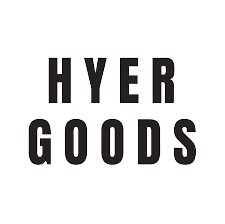
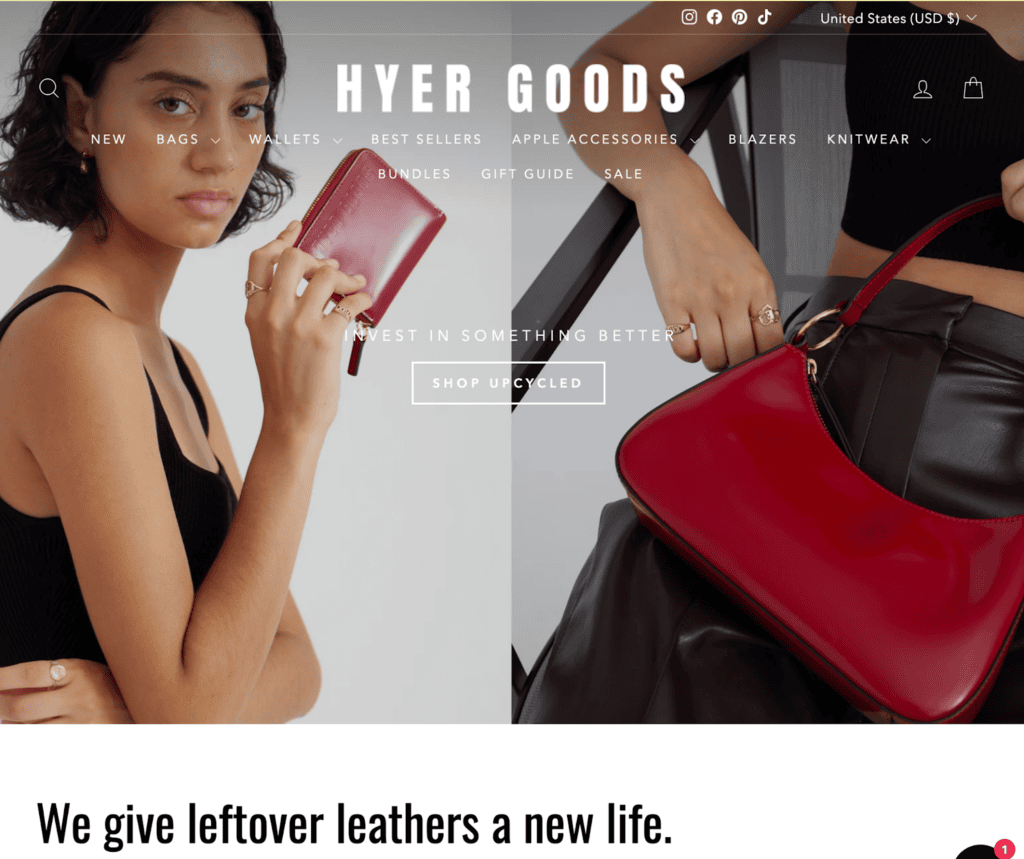
“By upcycling “trash” we eliminate the massive energy footprint needed to cultivate land, livestock, crops and fertilizers, while simultaneously reducing the amount of waste being sent to landfill. ”
HYER GOODS
🌎
How do they ensure their sustainability?
HYER GOODS ensures their sustainability by rescuing yarns and fabrics abandoned by the fashion industry and turning them into beautiful bags, clothing items, and accessories.
- For example, their Luxe Mini Bucket Bag is cut from leather leftovers. Their entire collection of bags, wallets, jackets, and beanies are also crafted from deadstock, surplus, and leftovers, including luxury leftover leather, deadstock leather, locally sourced abandoned wool yarns, and deadstock canvas.
- Regarding their leather materials, HYER GOODS prioritizes using animal skins that are vegetable-tanned and made in Italy, utilizing some of the world’s best leather production methods. Also, all of the ready-made leather leftovers they source are tested for chrome, ensuring the leather is safe to wear. Beyond reducing carbon emissions through diverting textile waste from landfills, HYER GOODS offsets 100% of their carbon emissions from shipping.
- Lastly, they partner with EcoCart to support Global Sustainable Infrastructure Projects, investing in multiple sustainable infrastructure carbon offset projects, like wind and solar farms, biogas, and hydropower.
🌐
How do they ensure their ethics?
HYER GOODS traces most of their supply chain and audits their final stage of production.
🤝
Are they part of any giving-back programs?
HYER GOODS has pledged to donate 1% of net sales on their site to support organizations that foster the physical and mental well-being of people in need. Some of the previous recipients of their donations are the Malala Fund, WHO, No Kid Hungry, and The Okra Project.
🛍️
What is their product range?
- Best for: menswear, womenswear
- Product range: bags, wallets, blazers, beanies, scarves
- Price range: $$$
- Size range: XS–L
Johnstons of Elgin: Wool Accessories From Established Luxury Clothing Label

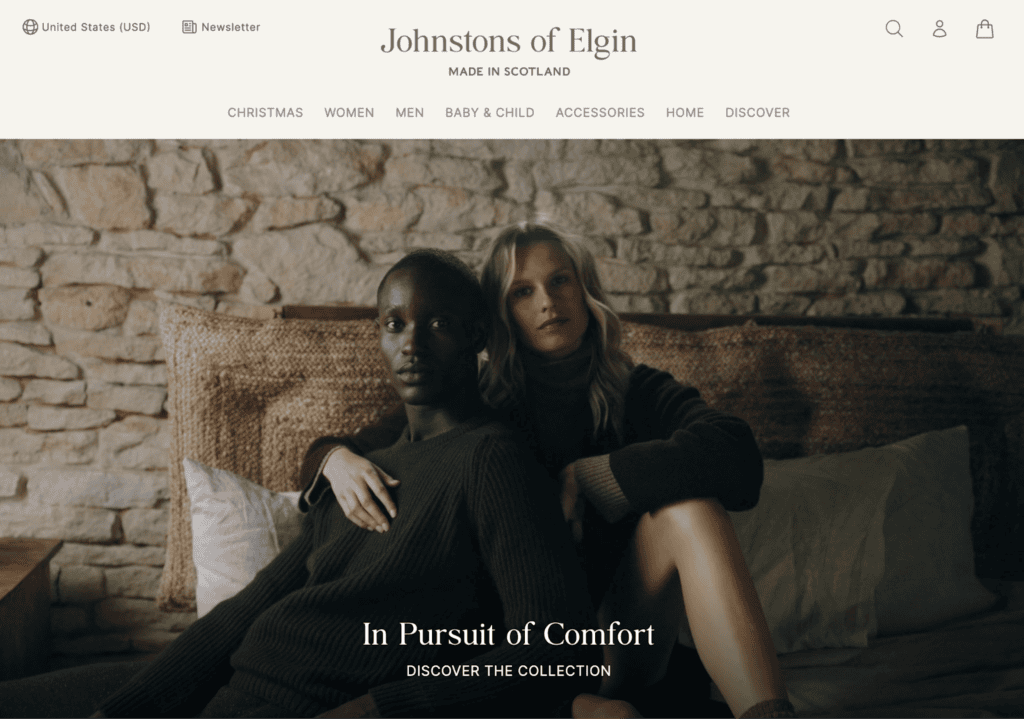
“We have worked with natural, renewable, biodegradable fibres since 1797 and strive to reduce our environmental footprint year after year.”
Johnstons of Elgin
🌎
How do they ensure their sustainability?
Johnstons of Elgin prioritizes sustainability by setting up a low-carbon footprint and low-waste production using mainly natural fibers while working to preserve grasslands, the starting point of their cashmere fibers.
- Natural fabrics, including cashmere, merino lambswool, and sheep wool account for 99.88% of all fibers used in their portfolio. Further down the life-cycle in the manufacturing stage, Johnstons of Elgin strives to reduce manufacturing waste; in fact, 87% of their manufacturing waste is recycled to create other products. Specifically, batch ends of yarns and cut-offs are redyed to be used in scarves, while waste fiber goes into fillings or insulation materials whenever possible. Plastic, if used during the manufacturing process, is reused or recycled.
- Furthermore, the brand lowers their carbon footprint by increasing energy efficiency and working with energy providers possessing renewable energy certificates. Johnstons of Elgin’s incentives in reducing energy usage include investing in energy-efficient lighting, improving boiler maintenance, and implementing air-source heat pumps. Johnstons of Elgin also uses low-impact, non-toxic dyes in all of their products.
- Lastly, they strive for circularity by opting for high-quality, recyclable materials; offering repair services; and facilitating the recycling of their cashmere products.
🌐
How do they ensure their ethics?
Johnstons of Elgin ensures their ethics by striving for transparency in how their products are made.
- Some of their products now have a Digital ID, enabling traceability from fiber to finished garment.
- Regarding the people making their products, they pay a living wage, provide training for personal development, recognize trade unions, and uphold health and safety. They also trace most of their supply chain.
- Furthermore, animal welfare is held at the heart of their operation. Specifically, they source cashmere with Sustainable Fibre Alliance (SFA) certification and mulesing-free merino sheep wool and lambswool with Responsible Wool Standard certification.
🤝
Are they part of any giving-back programs?
Johnstons of Elgin is one of three founding members of the Sustainable Fibre Alliance (SFA), a nonprofit international organization working in the cashmere supply chain. SFA funds various programs in Mongolia to train communities and promote ecological and social projects to restore grasslands, ensure animals’ well-being, and secure herders’ livelihoods. For example, their Young Herders program, “Kharaatsai” (Young Swallows), gives students a deeper understanding of their natural environment through biodiversity, weather patterns, and soil health classes.
🛍️
What is their product range?
- Best for: womenswear, menswear, kidswear
- Product range: jackets, blazers, hoodies, sweatshirts, sweaters, coats, hats, gloves, socks, pants
- Price range: $$$$
- Size range: XS–XXL
Nisolo: Leather Accessories From an Accountable, Transparent, and Carbon-Neutral Brand


“As a brand focused on sustainability, we’re far from perfect. To hold ourselves more accountable in hopes the industry will begin to do the same, we’re raising the bar for transparency to an unprecedented level. ”
Nisolo
🌎
How do they ensure their sustainability?
Nisolo ensures their sustainability by reducing their impacts while working toward fixing the fashion industry. They focus on five critical areas: a living wage for all workers, net zero carbon emissions, transparency, accountability, and collaboration. Specifically, they pursue the balance between their carbon emissions and offsets.
- Firstly, Nisolo strives to reduce their carbon emissions throughout the life-cycle of their leather footwear and accessories. They opt for recycled and upcycled materials, sourcing synthetic materials made from recycled water bottles and leather as an economic by-product of the meat industry. Further down the life-cycle in the manufacturing stage, they use renewable energy for a significant percentage of their production.
- At the end of the product’s life-cycle, they facilitate recycling and responsible disposal through their takeback program with Soles4Souls, further reducing the life-cycle’s environmental impacts. Since 2018, Nisolo has offset all the carbon emissions that they haven’t managed to cut by partnering with Ecosphere+ to invest in forest conservation in the Peruvian Amazon—an offsetting project verified by Climate Neutral.
- Lastly, they are a carbon-neutral certified brand.
🌐
How do they ensure their ethics?
Nisolo ensures their ethics by upholding all their 1st tier factories to their Supplier Code of Conduct, which covers all of the ILO’s Fundamental Principles and Rights at Work.
- They ensure that every producer in their 1st tier factories is paid a living wage by monitoring individual living wages and tracking suppliers’ lowest wages. Nisolo also monitors health and safety issues with an internal procedure.
- Moreover, they are fully transparent about their impacts with their sustainability facts labels so that consumers can see the carbon footprint and the workforce involved with each product they purchase.
- Regarding animal welfare, Nisolo is a member of the Leather Working Group, which promotes sustainable environmental practices in the leather industry.
🤝
Are they part of any giving-back programs?
Nisolo founded The Lowest Wage Challenge in collaboration with another fashion label, ABLE, to challenge brands to share their lowest wages and strive toward paying their workers a living wage throughout their supply chains.
🛍️
What is their product range?
- Best for: menswear, womenswear
- Product range: shoes and accessories (belts, wallets, bags)
- Price range: $$$
- Size range: S–L
BOTTLETOP: Handbags Made Ethically With Upcycled, Recycled, and Certified Materials
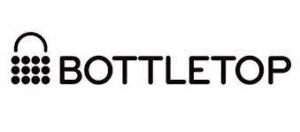
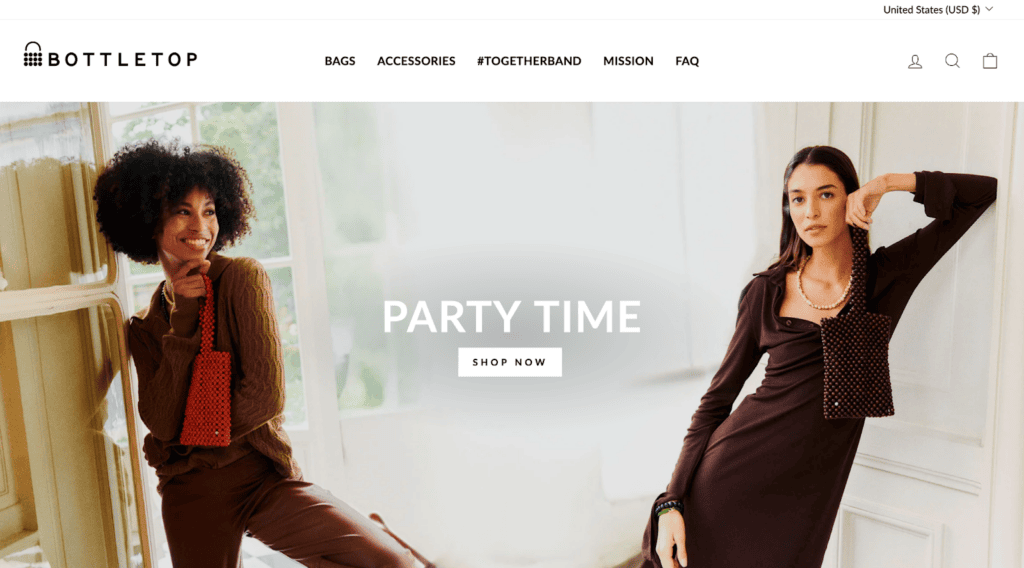
“I would always encourage people to ask the tough questions of brands that they love and would want to see improving, and for everyone to use their actual voice and their digital voice to make noise.”
Cameron Saul, Co-founder of BOTTLETOP
🌎
How do they ensure their sustainability?
BOTTLETOP ensures sustainability by sourcing a high proportion of eco-friendly materials. Specifically, they opt for upcycled and recycled materials to help tackle today’s waste problems.
- Their signature chain mail fabric, found in items such as their Amazona Mini Enamel clutch, is woven with upcycled aluminum rings collected from the streets of Brazil. BOTTLETOP also upcycles stainless steel from deconstructed illegal firearms that have been seized by local authorities in Central America.
- Furthermore, the brand sources food and plastic waste to create handbag materials.
- Regarding leather—the conventional material for luxurious handbags—BOTTLETOP ensures that they only source animal hides from sustainable farms and have them processed in a tannery that is rated Gold standard by the Leather Working Group (LWG). Further down the life-cycle in the manufacturing stage, BOTTLETOP reduces their energy use and climate impact by making products by hand.
🌐
How do they ensure their ethics?
BOTTLETOP traces most of their supply chain, including the final production stage, and visits their supplier regularly.
- Additionally, they have created the first certified ‘Zero Deforestation Leather’ supply chain with the National Wildlife Federation.
- They have also advocated for consumers and brands in the fashion industry to demand to know the provenance of their leather in order to help ensure both animal welfare and traceability, supporting the protection of the Amazon rainforest and other natural environments.
🤝
Are they part of any giving-back programs?
BOTTLETOP has a giving-back program through the BOTTLETOP Foundation, which supports grassroots health education charities that empower young people to protect themselves. BOTTLETOP also launched the #TOGETHERBAND campaign in partnership with the UN Foundation in 2019, with a mission to generate global awareness and action supporting the 17 UN Sustainable Development Goals. The campaign has generated over 9 billion impressions and has over 1,000 ambassadors from around the world. They now hold their atelier and training programs in Brazil and Nepal. Additionally, BOTTLETOP partners with two Nepalese organizations to support female victims of human trafficking.
🛍️
What is their product range?
- Best for: womenswear
- Product range: bags, purses, pouches, belts, bag accessories
- Price range: $$
- Size range: n/a
Ecoalf: Committing to Recycling Waste and Cleaning the Environment


“I believe the time when fashion was just about looking good is over. More than ever it has to be about doing what is right and feeling good about it.”
Javier Goyeneche, founder of Ecoalf
🌎
How do they ensure their sustainability?
Ecoalf’s commitment to sustainability is evident in their innovative recycling practices.
- They minimize the use of natural resources by using mainly waste as raw materials, collecting and transforming discarded materials into recycled fabrics like recycled polyester, recycled nylon, recycled cotton, recycled wool, and recycled cashmere.
- In 2023, they launched their first 100% recycled cotton collection that can be recycled again to achieve circularity. Back further in 2021, 74% of the materials used by Ecoalf were recovered from waste, saving 1,377 tons of CO₂.
- In combination with recycled fabrics, Ecoalf uses a small percentage of low-impact natural fabrics, such as linen and kapok. Ecoalf is also Bluesign® and B Corporation certified.
🌐
How do they ensure their ethics?
Ecoalf ensures their ethics by protecting their workers and the environment.
- In particular, they ensure there are safe and fair working conditions in their supply chain by mandating a Code of Conduct, an Equality Scheme, a Crime Prevention Handbook, a Disciplinary System, and a Bullying at Work Protocol.
- Additionally, they run many campaigns to raise awareness of the state of our oceans and earth-damaging consumerism habits.
🤝
Are they part of any giving-back programs?
Ecoalf actively participates in giving-back programs. The Ecoalf Foundation was founded to clean the oceans of marine waste with the help of the fishing industry while giving a second life to plastic waste through recycling and closing the loop. They achieve that with the “Upcycling the Oceans” projects. In 2021, Ecoalf donated 10% of all Because There’s No Planet B sales to the Ecoalf Foundation to expand the “Upcycling the Oceans” project beyond the Spanish border and into countries like Thailand, Greece, and France. The foundation also partners with Biotherm to set up the framework of “Limpia ríos, salva océanos”, a project supported by corporate volunteer days to collect waste and restore the environment. Additionally, Ecoalf’s employees volunteer in various environmental incentives.
🛍️
What is their product range?
- Best for: womenswear, menswear, kidswear
- Product range: shirts, pants, jackets, blazers, hoodies, sweatshirts, tops, blouses, knitwear, T-shirts, sneakers, accessories
- Price range: $$
- Size range: XS–XL
O My Bag: Eco-Leather Handbags Made by a Social Enterprise

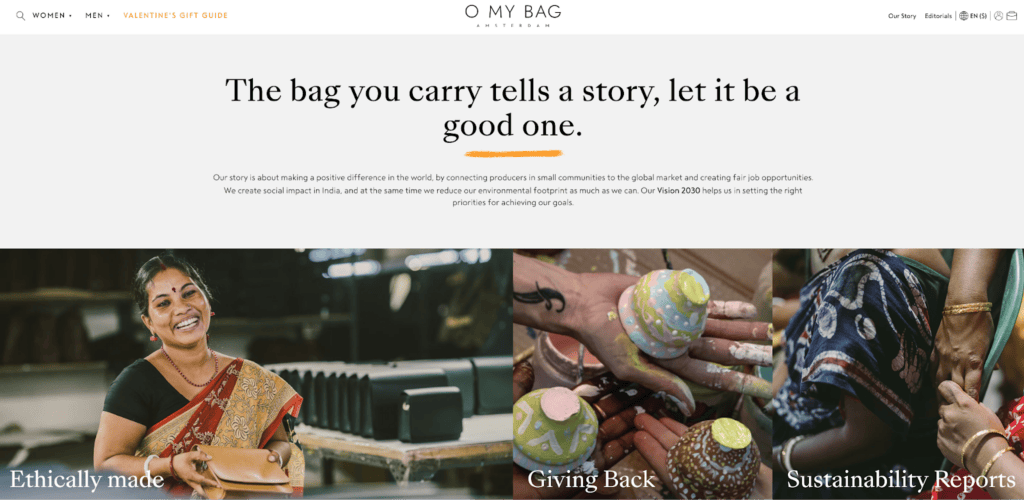
“We create social impact in India, and at the same time we reduce our environmental footprint as much as we can. ”
O My Bag
🌎
How do they ensure their sustainability?
O My Bag prioritizes sustainability by reducing and offsetting their carbon emissions.
- Firstly, they focus on lowering carbon emissions, which they call “in-setting”. The carbon reduction incentives include increasing sea shipments, replacing the fossil fuels used for their sea shipments with biofuels, limiting business travel, flying on Sustainable Aviation Fuel for business trips, and searching for a more sustainable hardware producer. For example, in 2022, sea shipment accounted for 36% of their total shipment, a significant increase from 16% in 2021.
- Secondly, the emissions that cannot be prevented are offset in the Indian clean cooking stoves project of FairClimateFund. Additionally, O My Bag lowers their impact by opting for durable materials sourced and produced sustainably. The main textile used in their bags is premium quality leather naturally tanned without using chromium, reducing chemical and water usage in production. They work with Leather Working Group (LWG) certified tanneries to ensure best practices in processing their raw materials. To accommodate some customers’ choice not to purchase animal products, they produce a vegan bag collection made with AppleSkinTM. O My Bag also uses low-impact GOTS-certified organic cotton and GRS-certified recycled cotton for the lining of their handbags. Regarding packaging, O My Bag orders are sent in cardboard boxes made from recycled materials and are certified by the Forest Stewardship Council (FSC).
- Lastly, O My Bag actively reduces waste with a Second Chance Collection, selling Perfectly Imperfect and Pre-Loved items that they take back from customers, diverting bags away from landfills for a longer lifespan.
🌐
How do they ensure their ethics?
O My Bag ensures their ethics by committing to fair jobs and living wages.
- They also pay a living wage premium, which tripled from 2021 to 2022. Additionally, they bind their suppliers to a Code of Conduct that covers all of the ILO’s Fundamental Principles and Rights at Work.
- They also trace most of their supply. The final production stage is also certified by Social Accountability International – SA8000 and the WFTO Guarantee System.
🤝
Are they part of any giving-back programs?
O My Bag donates 1% of their annual revenue to social impact projects in and around Kolkata, India. These projects focus on women’s empowerment, education, and environmental innovation.
🛍️
What is their product range?
- Best for: womenswear, menswear
- Product range: bags, accessories
- Price range: $$$
- Size range: n/a
Whelk: Sustainable Headwear Brand Giving Back to Ocean-Cleaning Efforts

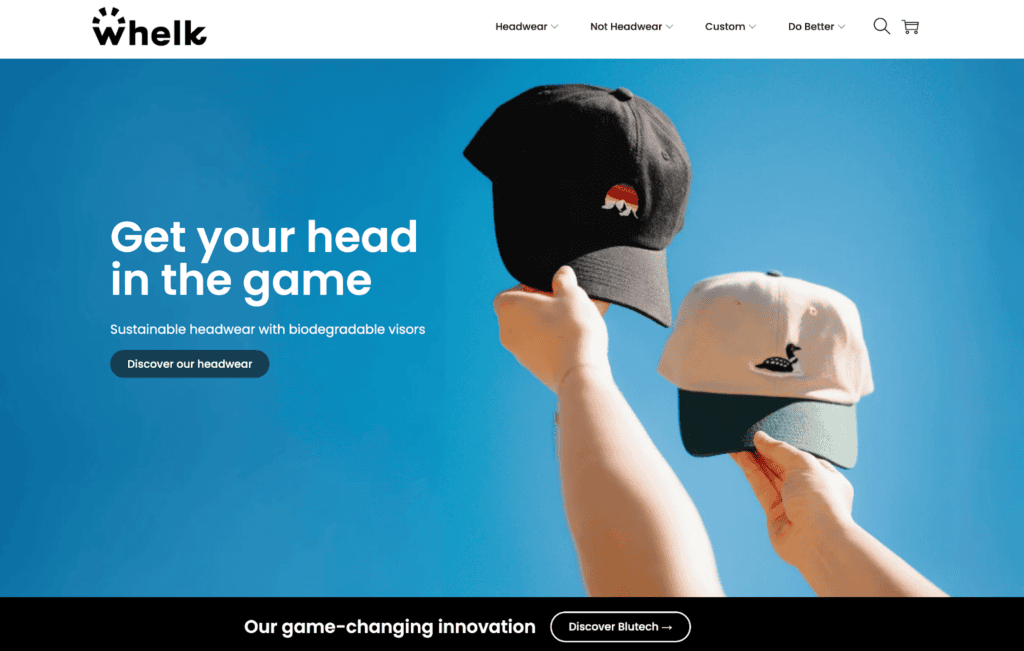
“We analyze every detail, looking for ways to improve. We just want to do what is best for people and the planet.”
Whelk
🌎
How do they ensure their sustainability?
Whelk ensures their sustainability by sourcing low-impact materials, minimizing waste, and reducing their climate impact.
- Firstly, they prioritize natural materials over synthetic ones both in the products and in the packages. Specifically, Whelk sources recycled cotton and OEKO-TEX STANDARD 100®-certified cotton in a high percentage of their hats. Their commitment to natural materials also extends to using recyclable cardboard boxes instead of plastic poly mailers as packaging. In contrast, whenever synthetic materials are used, Whelk opts for the ones with the lowest environmental impact, such as recycled polyester or an innovative plastic material that biodegrades. Their Blutech visors are made of plastic mixed with the Blutech additive, which attracts microbes that feed on plastic and enables biodegradation.
- Secondly, the brand strives to minimize waste, including designing products that last a lifetime without planned obsolescence, utilizing discarded objects to make their ReCap Upcycled accessories, and employing minimal packaging.
- Lastly, Whelk reduces their environmental impact by powering their website using a data center that gives back three times the renewable energy it consumes and having part of their production held locally in Canada to avoid long-distance shipping.
🌐
How do they ensure their ethics?
Whelk ensures their ethics by partnering with certified factories. Their caps are manufactured in a Vietnam facility that complies with WRAP, guaranteeing good and fair working standards.
🤝
Are they part of any giving-back programs?
As a member of 1% for the Planet, Whelk commits to donate 1% of their annual sales to ocean-cleaning efforts.
🛍️
What is their product range?
- Best for: unisex
- Product range: sport caps, baseball caps, bucket hats, beanies, fleeces, belt bags,
- Price range: $$
- Size range: n/a
Mila.Vert: PETA – Approved Vegan Knitwear Made From Organic Cotton

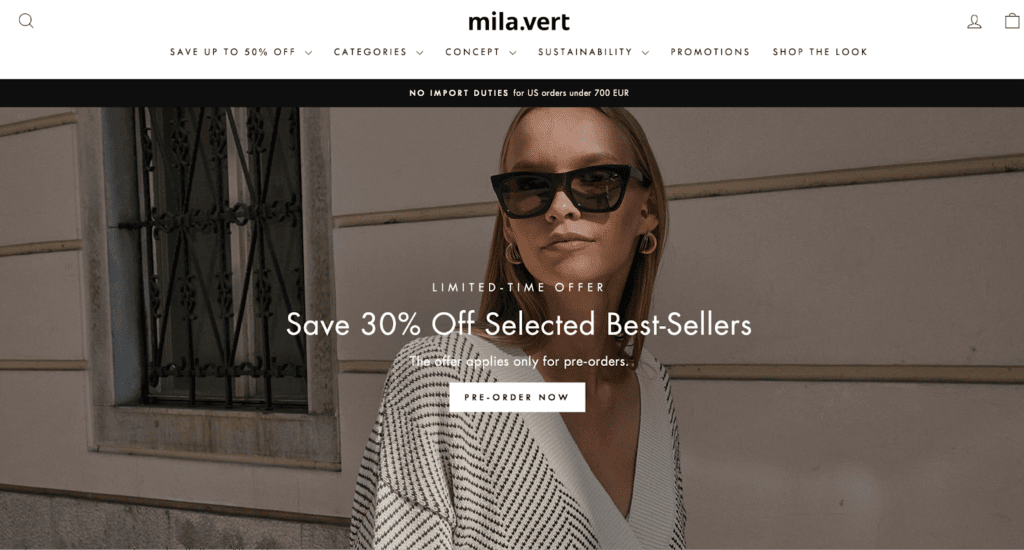
“Every single Mila.Vert piece is sustainably produced on-demand. By keeping no stock and only producing what you order, we avoid over-production, cut down waste and preserve precious resources to deliver high-quality ethical fashion.”
Tina Logar Bauchmüller, founder of Mila.Vert
🌎
How do they ensure their sustainability?
Mila.Vert’s sustainability efforts focus on using eco-friendly materials and doing fashion on demand.
- Firstly, they carefully select sustainable fabrics for their garments. These include GOTS-certified organic cotton, European linen, TENCELTM, EcoVeroTM, and recycled wool. The brand is also environmentally conscious about their packaging choices, opting for bags made from fabric scraps and containing no plastic.
- Secondly, they operate on pre-order runs, keeping no stock and only producing what’s ordered. Consequently, they avoid overproduction, reduce waste, and preserve natural resources to deliver high-quality, ethical fashion.
- Lastly, Mila.Vert manufactures locally in Slovenia, keeping transporting distances and associated carbon emissions relatively low.
🌐
How do they ensure their ethics?
Mila.Vert upholds their suppliers to a Code of Conduct that covers four of the ILO’s Fundamental Principles and Rights at Work.
- The brand also traces most of their supply chain and audits some of their suppliers.
- Furthermore, they publicly share their manufacturing partners and their supplier for organic cotton used in their knitwear.
- Regarding animal welfare, they opt out of animal-derived textiles, except for a small amount of recycled wool used in their coats.
🤝
Are they part of any giving-back programs?
Mila.Vert is not known to be part of any giving-back programs.
🛍️
What is their product range?
- Best for: womenswear
- Product range: pullovers, cardigans, coats, jackets, dresses, tops, pants, skirts, shirts, blouses, accessories
- Price range: $$$
- Size range: XS–XL
BEEN London: Timeless Handbags From Recycled Leather Offcuts and Plastic Bottles
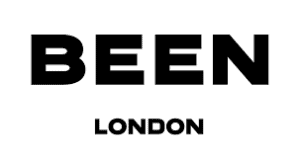
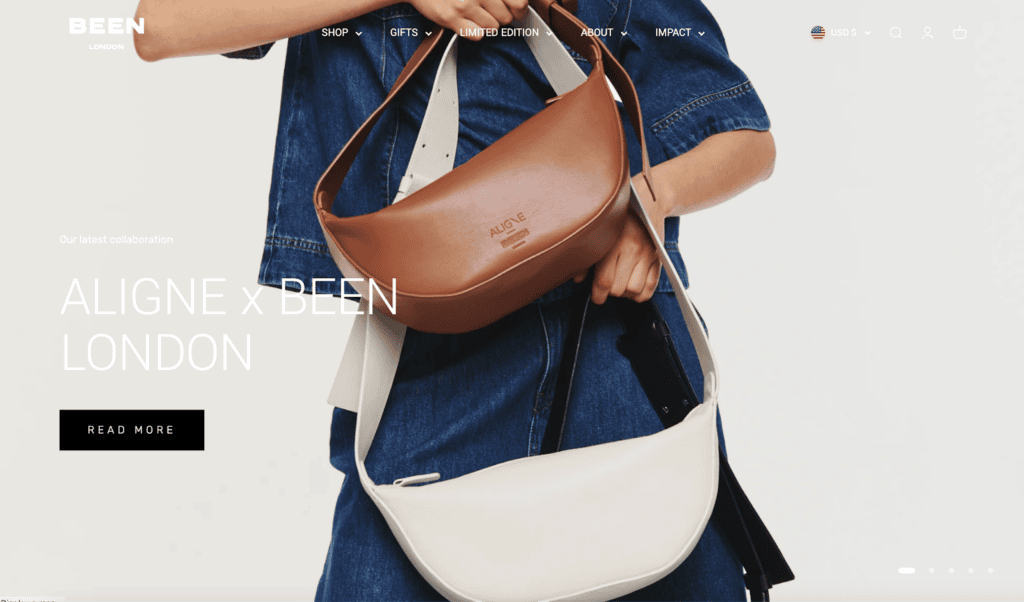
“We make versatile, timeless accessories from discarded materials that would otherwise go to landfill. In doing so, we are shifting the narrative around waste, showing what is possible with new innovations, and doing our part to protect nature.”
BEEN London
🌎
How do they ensure their sustainability?
BEEN London’s sustainability efforts focus on circularity.
- They start with reverting waste away from landfills and into making clothing accessories. BEEN London also uses a high proportion of low-impact materials, including GRS-certified recycled materials from post-consumer plastic bottles, fishing nets, plant-derived waste, used textiles, and leather offcuts and trimmings. Specifically, they source recycled leather, recycled nylon, recycled polyester, recycled cotton, and recycled fell.
- Additionally, they have some bags made with vegan leather alternatives, including Piñatex and AppleSkinTM, made with agricultural and industry waste. Beyond sourcing, BEEN London also considers circularity in every decision. Specifically, they strive to limit the amount of waste they create through their design process, such as opting for making mostly rectangular bags with which they can achieve near zero offcuts. Any offcuts that are created in the production process are collected and recycled.
- Furthermore, they design durable, versatile, seasonless, timeless pieces that consumers will still want to wear year after year. BEEN London helps extend product lifespan by offering repairs and incentivizing end-of-life recirculating. The design of their bags also covers end-of-life recycling, meaning that they preempt the dismantling challenges by stitching the lining to bags and using water-soluble glues or leaving their bags unlined. When reuse and repair are no longer an option, customers can send their bags back to BEEN London, where they will be dismantled for material recycling.
- Lastly, BEEN London strives to reduce their climate impact by opting for sea freight and offering zero-emission London delivery.
🌐
How do they ensure their ethics?
BEEN London makes everything locally in East London to ensure the highest level of transparency. They also trace all of their supply chain and visit their suppliers regularly.
🤝
Are they part of any giving-back programs?
BEEN London gives back by planting trees in the Amazon Rainforests. They plant a tree for every leather item in the color Rainforest Green ordered and sold. The impact of their reforestation efforts is tracked via Forest of BEEN London on their partner platform, Tree-Nation. Additionally, BEEN London supports Smart Works, a charity that gives women the confidence they need to reach their full potential by incentivizing customers to bring or mail (pre-paid) their pre-loved bags from any brand for recirculating.
🛍️
What is their product range?
- Best for: womenswear
- Product range: backpacks, handbags, satchels, totes, wallets, purses
- Price range: $$$
- Size range: n/a
Raven + Lily: Sustainably Designed and Responsibly Produced Handbags and Accessories

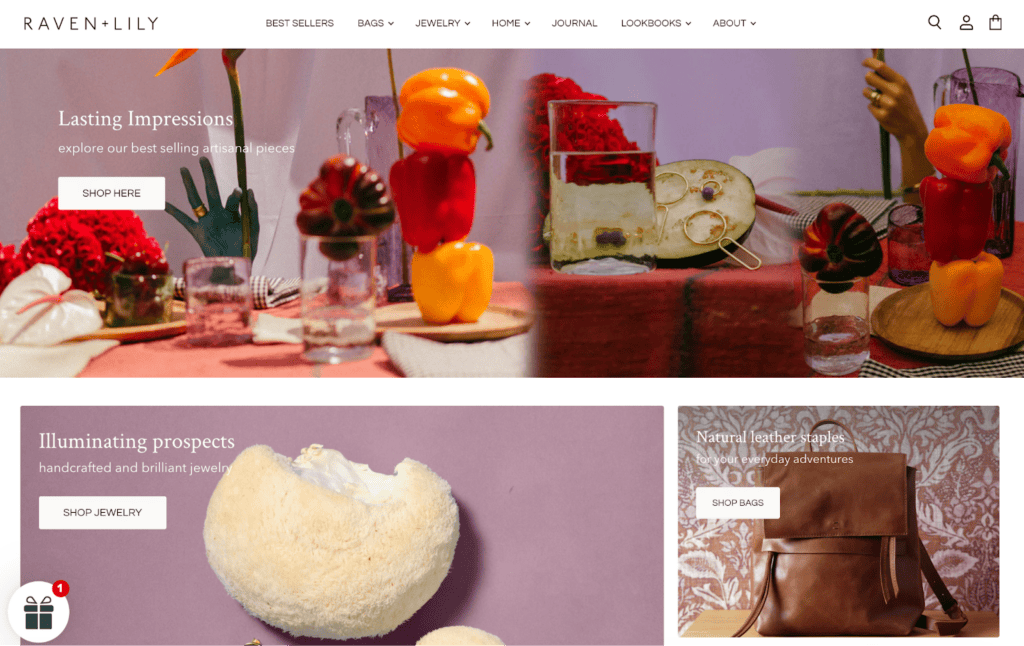
“All of our pieces are made in studios and nearly everything is handcrafted, which requires time and great skill. Designed and made to last, we believe less is more and favor longevity over trends.”
Raven + Lily
🌎
How do they ensure their sustainability?
Raven + Lily ensures sustainability by prioritizing locally sourced, biodegradable natural materials.
- They reduce their environmental impacts by upcycling leather remnants to make new handbags and upcycling brass and glass for their jewelry and homeware collections.
- Some Raven + Lily bags are made with low-impact cotton (organic cotton and recycled cotton).
- Additionally, they design products for longevity and to be appreciated year after year, reducing the life-cycle’s impact.
🌐
How do they ensure their ethics?
Raven + Lily partners with artisans and independent makers to produce their products.
- They also ensure payment of a living wage in the final stage of production while monitoring health and safety issues with an internal procedure.
- Lastly, they trace most of their supply chain.
🤝
Are they part of any giving-back programs?
Raven + Lily commits to giving back 1% of their sales to organizations that share their ethos and principles, including Women’s Fund at the Austin Community Foundation, the SAFE Alliance, and local and national organizations that support Black Lives Matter (NAACP, Reclaim the Block, and the African American Youth Harvest Foundation).
🛍️
What is their product range?
- Best for: menswear, womenswear
- Product range: low-top sneakers, high-top sneakers, socks, accessories
- Price range: $$
- Size range: XS–XXL
Zestt Organics: Organic Cotton Scarves for Travelling and for Everyday Life


“We strive to provide our customers with the highest quality textiles while working to protect the environment and the people behind our products.”
Zestt Organics
🌎
How do they ensure their sustainability?
Zestt Organics ensures their sustainability by sourcing and manufacturing according to the strictest organic standards.
- They use exclusively organic cotton fibers farmed and harvested certified by the Global Organic Textile Standard.
- Similarly, they partner with GOTS-certified factories to ensure all the production stages, from dyeing to packaging, are toxic-free.
🌐
How do they ensure their ethics?
Zestt Organics ensures their ethics by committing to the Global Organic Textile Standard.
- These strict social standards guarantee that each scarf is ethically made and free from child labor.
- Additionally, the brand is committed to total transparency in their supply chain. Their Lot No. program allows customers to check to see where and who was responsible for making each of their women’s scarves.
🤝
Are they part of any giving-back programs?
Zestt Organics is not known to be part of any giving-back programs.
🛍️
What is their product range?
- Best for: womenswear
- Product range: scarves
- Price range: $$
Sustain by Kat: Organic Clothing Free of Synthetic Dyes


“Sustain’s goal is to make clothing that is more than just low impact. We create clothing that actually has a positive impact on our world, helping both the environment and the people in it.”
Sustain by Kat
🌎
How do they ensure their sustainability?
Sustain by Kat prioritizes sustainability by sourcing plant-based fibers and dyes to eliminate harmful chemicals and help remove carbon from the atmosphere.
- Firstly, they use a high proportion of low-impact plant fibers, including organic cotton and linen. Further down the life-cycle in the manufacturing stage, Sustain by Kat opts for using exclusively natural dyes made from various plant materials, such as pomegranate peels, oak galls, rhubarb, myrobalan fruits, madder root, fustic wood, logwood, and indigo leaves.
- The brand also offers apparel completely free of dyes, chemical bleaches, optical brighteners, and synthetic softeners.
- Lastly, all their packaging is made from 100% recycled materials and is fully recyclable. They ship orders using 100% recycled poly mailers (which include 50% post-consumer waste) with a reusable tear strip for reuse and easy returns or exchanges. Their shipping labels and internal packaging, including invoices, wrapping, and even their stickers, are made from 100% recycled paper using post-consumer waste.
🌐
How do they ensure their ethics?
Sustain by Kat traces most of their supply chain. They state that they provide fair wages and safe working conditions to support small, marginalized communities in India where their Ayurvedic collection is produced. The rest of their apparel is made locally in the US.
🤝
Are they part of any giving-back programs?
Sustain by Kat is not known to be part of any giving-back programs.
🛍️
What is their product range?
- Best for: womenswear, kidswear
- Product range: tanks, tees, shirts, blouses, shorts, pants, underwear, bras, accessories underwear
- Price range: $$
- Size range: XS–XL
Opera Campi: Italian-Made, Innovative Hemp Fabrics Offset by Tree Planting


“We pioneer a radical concept of sustainability based on flexible production, new hemp-based material, minimal packaging and more.”
Opera Campi
🌎
How do they ensure their sustainability?
Opera Campi ensures their sustainability by making innovative low-impact fabrics based on hemp fibers, in consideration of the plant’s high carbon sequestration potential and low irrigation requirement.
- Their hemp T-shirt’s emission is less than 3kg CO2, which is half of a common cotton T-shirt’s emission.
- Their Zero Sweater, an undyed hemp knitwear, is carbon-negative (cradle-to-gate). Opera Campi also operates a made-to-order system, preventing fabric waste and saving water. On top of that, they use simple packaging, which is either recyclable or compostable.
- Additionally, Opera Campi plants two trees for every clothing item ordered, offsetting carbon emissions during the manufacturing and transporting stages.
🌐
How do they ensure their ethics?
Opera Campi engineers, designs, and produces their hemp clothing in Italy, an EU member country upholding the group standards about fair wages and safe working conditions. They also trace most of their supply chain.
🤝
Are they part of any giving-back programs?
Opera Campi plants two trees for every garment ordered.
🛍️
What is their product range?
- Best for: menswear, womenswear,
- Product range: shirts, pants, jackets, blazers, knitwear, T-shirts, shorts, plus-size
- Price range: $$$
- Size range: XXS–XXXL
Unrecorded: Unisex Clothing Made Sustainably With Consideration to Quality and Elegance


“In our determined pursuit of refinement, we embrace the charm of natural fibers, carefully chosen for their exceptional durability and resilience. ”
Unrecorded
🌎
How do they ensure their sustainability?
Unrecorded ensures sustainability by using a high proportion of low-impact natural fabrics, lowering carbon emissions, and minimizing textile waste.
- They craft their designs using a selection of natural fibers, including lambswool and sheep wool with RWS certification and from non-mulesed sheep.
- They also use linen, hemp, recycled cotton, and organic cotton with GOTS certification.
- Additionally, they strive to incorporate more Dutch-made fabrics to reduce the transporting footprint between sourcing and manufacturing factories in Portugal and Italy.
- Lastly, all of their orders are shipped in FSC-certified cardboard boxes.
🌐
How do they ensure their ethics?
Unrecorded sets up their final stage of production in the European Union, a low/medium risk region for labor abuse.
- They also trace most of their supply chain and visit their suppliers regularly.
- Regarding animal rights, they follow the Responsible Wool Standard, appropriately addressing sheep’s welfare and the land they graze on.
🤝
Are they part of any giving-back programs?
Unrecorded is not known to be part of any giving-back programs.
🛍️
What is their product range?
- Best for: unisex apparel
- Product range: knitwear, sweaters, hoodies, pants, shirts, T-shirts, polo shirts, outerwear, socks, scarves, hats, accessories
- Price range: $$
- Size range: XS–XXL
Why Is It Important to Buy Products Made of More Sustainable Fabrics
It is important to buy products made of more sustainable fabrics because a sustainable textile industry has a lower carbon footprint, helps save natural resources, and is better for forests, animals, and humans.
Buying Sustainable Fabrics Reduces Your Carbon Footprint
The production of clothing and footwear is estimated to contribute 10% of global greenhouse gas emissions—more than all international flights and shipping combined. If the fashion industry were a country, it would be the fourth largest emitter of carbon dioxide.
One way to reduce the carbon footprint of the clothes you buy is to opt for sustainable fabrics. Sustainable fabrics, which are often made with natural or recycled fibers, have relatively low carbon footprints compared to petroleum-based fabrics. For example, organic cotton made in the US has a carbon footprint of 2.35 kg CO2 (per ton of spun fiber)—a quarter of polyester’s carbon footprint.
Buying Sustainable Fabrics Reduces Demand For Natural Resources and Waste Management
The textile industry uses water and land to grow cotton and other fibers. It is estimated that 79 billion cubic meters of water were used for the sector worldwide in 2015. For example, producing a single cotton T-shirt requires as much water as one person drinks for 2.5 years (2,700 liters of fresh water).
Worse yet, the textile economy is vastly more linear than circular: the largest amount of resources used in clothes ended up in landfills (instead of being recycled to remake clothes). According to a report by the Ellen MacArthur Foundation,
- Less than 3% of materials used in the textile economy in 2015 came from recycled sources.
- In other words, more than 97% of resources used in making clothes are newly extracted.
When clothing items are disposed of within a short period of time—under a year in the case of half of the fast fashion clothes—the natural systems that provide raw materials for fabrics don’t have enough time to recover and regenerate, which could lead to ecological breakdown.
Sustainable fabrics are made with less water and emissions while lasting longer:
- Because they are durable, you don’t need to buy new clothes too often.
- Thus, you help reduce the pressure to extract more resources for making new items.
Similarly, making and consuming sustainable fabrics made with recycled materials reduces the demand for virgin materials while helping tackle waste management.
Buying Sustainable Fabrics Encourages Sustainable Management of Forests
Sustainable natural fiber fabrics are made with raw materials from forests and plantations that are sustainably managed, such as complying with FSC standards.
When you buy sustainable natural fiber fabrics, you discourage unsustainable forestry practices like illegal logging. You can help reduce deforestation, biodiversity loss, and the effects of climate change.
Buying Sustainable Fabrics Encourages Fairer Treatment of Animals
The fashion industry is rife with animal mistreatment when it comes to making animal-based fabrics like wool or silk. Every year, billions of animals suffer and die for clothing and accessories.
Buying sustainable vegan alternatives can help to reduce the pressure on raising more and more animals to meet the demand for animal-based fabrics while sacrificing their well-being and lives.
Suppose you have to buy fabrics made with, for example, wool or silk; make sure you only choose brands committed to cruelty-free products. In that case, you help advocate better treatments for animals raised within the textile industry.
Using Sustainable Fabrics Encourages Fairer Treatment of Textile Workers
Recent statistics from UNICEF estimated as many as 170 million child laborers worldwide, many of whom were engaged in some form of work in the textile industry. They don’t get paid minimum wages and often work long hours.
When you buy sustainable fabrics from brands transparent about the working conditions at their factories, you discourage the use of child labor and help promote better working conditions for textile workers.
How Can You Generally Buy More Sustainable Fabrics
The key to sustainably buying fabrics is to check on relevant environmental and original certifications.
For natural fabrics:
- Global Organic Textile Standard (GOTS): A globally recognized certification system that ensures a certain threshold of organic content has been met. It covers manufacturing, packaging, labeling, transportation, and distribution (but not what happens in the fields where crops are grown).
- USDA Certified Biobased Product: The USDA BioPreferred® Certification is a voluntary certification offered by the United States Department of Agriculture. The certification identifies products made from plants or other renewable materials.
- Ecolabel: Ecolabel is the official European Union voluntary label recognized worldwide for certified products with a guaranteed, independently verified low environmental impact. The label requires high environmental standards throughout the entire life-cycle: from raw material extraction through production and distribution to disposal. It also encourages companies to develop innovative, durable, easy-to-repair, and recyclable products.
For natural fiber semi-natural/semi-synthetic fabrics:
- Forest Stewardship Council: An FSC certification ensures that the wood (or wood-like material) comes from responsibly managed forests that provide environmental, social, and economic benefits.
There are two types of FSC Certification:- FSC Forest Management Certification, with a focus on the origin of the wood—the forest.
- FSC Chain of Custody Certification, which focuses on the path from the forest to the customer’s home.
- Program for Endorsement of Forest Certification: PEFC’s approaches to sustainable forest management are in line with protecting the forests globally and locally and making the certificate work for everyone. Getting a PEFC certification is strict enough to ensure the sustainable management of a forest is socially just, ecologically sound, and economically viable but attainable not only by big but small forest owners.
For recycled fabrics:
- Recycled Claim Standard (RCS): The Textile Exchange RCS was originally developed as an international, voluntary standard that sets requirements for third-party certification of Recycled input and chain of custody.
- The Global Recycled Standard (GRS): The Global Recycled Standard (GRS) is an international, voluntary, full product standard that sets requirements for third-party certification of Recycled Content, chain of custody, social and environmental practices, and chemical restrictions. It can be used for any product with more than 20% recycled material.
For all types of fabrics:
- STeP by OEKO-TEX®: STeP by OEKO-TEX® is an independent certification system for brands, retailers, and manufacturers from the textile and leather industry. It communicates organizational environmental measures, including reducing carbon footprint and water usage.
- OEKO-TEX® Standard 100: OEKO-TEX® labels aim to ensure that products pose no risk to human health (i.e., containing banned chemicals).
Some certifications that are signaling brands’ efforts toward lowered environmental impacts and a circular economy are:
- B Corp Certification: The label B Corp is a certification reserved for for-profit companies. Certified holders are assessed on their social and environmental impacts.
- Cradle2Cradle certification: Cradle2Cradle provides a standardized approach to material circularity. It assesses whether products have been suitably designed and made with the circular economy in mind covering five critical categories: material health, material reuse, renewable energy and carbon management, water stewardship, and social fairness.
Final Thoughts
Accessories can be among the higher-impact and less sustainable items due to their infrequent use and conventional use of high-impact materials. Thus, it is important to shop with ethics and sustainability in mind when choosing your next accessory.
By purchasing new or pre-loved accessories from brands that commit to sustainability, you support their mission to create a fairer and less harmful textile industry for all lives on Earth.
Here is the list (again) of the most sustainable accessories brands:
- Unbelts
- HYER GOODS
- Johnstons of Elgin
- Nisolo
- Bottletop
- Ecoalf
- Oh My Bag
- Whelk
- Mila.Vert
- BEEN LONDON
- Raven + Lily
- Zestt Organics
- Sustain by Kat
- Opera Campi
- Unrecorded
To make your use of these accessories even more sustainable, follow these steps:
- Buy second-hand, recycled, or upcycled accessories made with low-impact materials.
- Keep your accessories as long as possible.
- At the end-of-life of your accessories, upcycle the materials to extend their usage and arrange for them to be recycled or properly disposed of.
Stay impactful,

Sources
- Impactful Ninja: How Sustainable Are Leather Fabrics? A Life-Cycle Analysis
- Impactful Ninja: How Sustainable Are Wool Fabrics? A Life-Cycle Analysis
- Unbelts: Home
- Hyer Goods: Home
- Johnstons of Elgin: Home
- Nisolo: Home
- BOTTLETOP: Home
- Ecoalf: Home
- O My Bag: Home
- Whelk: Home
- Mila.Vert: Home
- BEEN London: Home
- Raven + Lily: Home
- Zestt Organics: Home
- Deux Mains: Home
- Opera Campi: Home
- Unrecorded: Home
- B Corporation: Unbelts
- Unbelts: Sustainability Report
- Unbelts: Unbelts Intrepid
- Impactful Ninja: How Sustainable Are Recycled Polyester Fabrics? A Life-Cycle Analysis
- Unbelts: Unbelts Loop Upcycled Accessories
- Good On You: Brand Directory | Unbelts
- Unbelts: Our Factories
- HYER GOODS: Bags
- HYER GOODS: Wallets
- HYER GOODS: Luxe Mini Bucket Bag
- HYER GOODS: Our Materials
- HYER GOODS: Luxury Leftovers
- HYER GOODS: Deadstock Leather Collection
- Impactful Ninja: How Sustainable Are Wool Fabrics? A Life-Cycle Analysis
- Impactful Ninja: How Sustainable Are Canvas Fabrics? A Life-Cycle Analysis
- HYER GOODS: Carbon Neutrality
- Good On You: Brand Directory | HYER GOODS
- HYER GOODS: Our Monthly Mission
- Malala Fund: Home
- WHO: Home
- No Kid Hungry: Home
- The Okra Project: Home
- B Corporation: Johnstons of Elgin
- Johnstons of Elgin: Accessories
- Johnstons of Elgin: SUSTAINABILITY | ENERGY & CARBON
- Johnstons of Elgin: SUSTAINABILITY | MANUFACTURING WASTE
- Johnstons of Elgin: SUSTAINABILITY | GRASSLAND PRESERVATION
- Impactful Ninja: How Sustainable Are Natural Fabrics? A Life-Cycle Analysis
- Impactful Ninja: How Sustainable Are Cashmere Fabrics? A Life-Cycle Analysis
- Impactful Ninja: How Sustainable Are Lambswool Fabrics? A Life-Cycle Analysis
- Impactful Ninja: How Sustainable Are Sheep Wool Fabrics? A Life-Cycle Analysis
- Johnstons of Elgin: SUSTAINABILITY | PLASTICS
- Johnstons of Elgin: IMPACT REPORT 2023
- Good On You: Brand Directory | Johnstons of Elgin
- Johnstons of Elgin: SUSTAINABILITY | CIRCULARITY
- CASHMERE CIRCLE: Johnstons of Elgin Cashmere Care Partnership.
- Johnstons of Elgin: WHAT IS A DIGITAL ID?
- Johnstons of Elgin: SUSTAINABILITY | FAIR WORK
- Johnstons of Elgin: SUSTAINABILITY | ANIMAL WELFARE
- Sustainable Fibre Alliance (SFA): THE SFA CASHMERE STANDARD
- Sustainable Fibre Alliance: Home
- Textile Exchange: Responsible Wool Standard
- Johnstons of Elgin: KHARAATSAI | Our Young Herders Programme in Mongolia
- B Corporation: Nisolo
- Nisolo: Men’s Accessories
- Nisolo: Women’s Accessories
- Nisolo: Women’s Leather Handbags, Totes & More
- Nisolo: Sustainability
- Impactful Ninja: How Sustainable Are Leather Fabrics? A Life-Cycle Analysis
- Impactful Ninja: How Sustainable Are Synthetic Fabrics? A Life-Cycle Analysis
- Nisolo: Can leather be sustainable?
- Nisolo: Behind The Scenes of Our Operation
- Nisolo: SHOE RECLAMATION PROGRAM
- Ecosphere+: Home
- Nisolo: How Our 0% Net Carbon Commitment Combats Climate Change AND, WHY WE’RE CLIMATE NEUTRAL CERTIFIED
- CHANGE CLIMATE: Nisolo is Carbon Neutral Certified
- Nisolo: Supplier Code of Conduct
- Good On You: Brand Directory | Nisolo
- International Labour Organization: ILO’s Declaration on Fundamental Principles and Rights at Work
- Nisolo: Our Lowest Wage & The Lowest Wage Challenge
- Nisolo: Sustainability Facts Label
- Leather Working Group: Home
- BOTTLETOP: Purses and Pouches
- BOTTLETOP: Belts
- Good On You: Brand Directory | BOTTLETOP
- BOTTLETOP: Sustainability
- BOTTLETOP: Amazona Mini Enamel
- Impactful Ninja: How Sustainable Are Leather Fabrics? A Life-Cycle Analysis
- Leather Working Group: Home
- BOTTLETOP: Artisan Production
- BOTTLETOP: Zero Deforestation Leather
- National Wildlife Federation: Home
- BOTTLETOP: BOTTLETOP Foundation
- BOTTLETOP: The BOTTLETOP Story
- BOTTLETOP: About #TOGETHERBAND Campaign
- Ecoalf: Women’s Accessories
- Ecoalf: Men’s Accessories
- Ecoalf: Materials
- Ecoalf: History
- Ecoalf: DON’T THINK IT’S A UTOPIA | DISCOVER OUR 2021 SUSTAINABILITY REPORT
- Impactful Ninja: How Sustainable Are Recycled Fabrics? A Life-Cycle Analysis
- Impactful Ninja: How Sustainable Are Recycled Polyester Fabrics? A Life-Cycle Analysis
- Impactful Ninja: How Sustainable Are Recycled Nylon Fabrics? A Life-Cycle Analysis
- Impactful Ninja: How Sustainable Are Recycled Cotton Fabrics? A Life-Cycle Analysis
- Impactful Ninja: How Sustainable Are Recycled Wool Fabrics? A Life-Cycle Analysis
- Impactful Ninja: How Sustainable Are Cashmere Fabrics? A Life-Cycle Analysis
- Impactful Ninja: How Sustainable Are Natural Fabrics? A Life-Cycle Analysis
- Impactful Ninja: How Sustainable Are Linen Fabrics? A Life-Cycle Analysis
- Impactful Ninja: How Sustainable Are Kapok Fabrics? A Life-Cycle Analysis
- B Corporation: Ecoalf
- Ecoalf: Sustainable Report 2021 | DON’T THINK IT’S A UTOPIA
- Ecoalf: ECOALF foundation
- Ecoalf: Upcycling the Oceans
- Ecoalf: Because There’s No Planet B
- Ecoalf: Personas
- B Corporation: O My Bag
- O My Bag: Women’s Accessories
- O My Bag: Men’s Accessories
- Impactful Ninja: How Sustainable Are Leather Fabrics? A Life-Cycle Analysis
- O My Bag: Carbon Strategy
- O My Bag: O My Bag Sustainability 2022
- FairClimateFund: Home
- O My Bag: Leather tanning process
- O My Bag: Sustainable Materials
- O My Bag: Tanneries
- O My Bag: Apple Leather
- Impactful Ninja: How Sustainable Are AppleSkinTM (Apple Eco Leather) Fabrics? A Life-Cycle Analysis
- Global Organic Textile Standard (GOTS): Home
- Impactful Ninja: How Sustainable Are Organic Cotton Fabrics? A Life-Cycle Analysis
- Textile Exchange: Global Recycle Standard
- Impactful Ninja: How Sustainable Are Recycled Cotton Fabrics? A Life-Cycle Analysis
- O My Bag: Shipping & Packaging
- Forest Stewardship Council: Home
- O My Bag: Second Chance Collection
- O My Bag: Perfectly Imperfect
- O My Bag: Pre-Loved
- O My Bag: Fair jobs
- O My Bag: Living wages
- O My Bag: Code of Conduct
- Good On You: Brand Directory | O My Bag
- International Labour Organization: ILO’s Declaration on Fundamental Principles and Rights at Work
- SA International: SA8000
- WFTO Guarantee System: Home
- O My Bag: Giving Back
- Whelk: F*ck Greenwashing
- Impactful Ninja: How Sustainable Are Recycled Cotton Fabrics? A Life-Cycle Analysis
- OEKO-TEX: OEKO-TEX® STANDARD 100
- Impactful Ninja: How Sustainable Are Cotton Fabrics? A Life-Cycle Analysis
- Impactful Ninja: How Sustainable Are Recycled Polyester Fabrics? A Life-Cycle Analysis
- Whelk: Blutech Visors
- Whelk: ReCap Upcycled Accessories
- WRAP Compliance
- One Percent for the Planet
- Mila.Vert: Knitwear Collection
- Mila.Vert: Accessories
- Mila.Vert: Our sustainable fabrics
- Global Organic Textile Standard (GOTS): Home
- Impactful Ninja: How Sustainable Are Organic Cotton Fabrics? A Life-Cycle Analysis
- Impactful Ninja: How Sustainable Are Linen Fabrics? A Life-Cycle Analysis
- Impactful Ninja: How Sustainable Are TENCELTM Fabrics? A Life-Cycle Analysis
- Impactful Ninja: How Sustainable Are EcoVeroTM Fabrics? A Life-Cycle Analysis
- Impactful Ninja: How Sustainable Are Recycled Wool Fabrics? A Life-Cycle Analysis
- Mila.Vert: Sustainability & Ethics
- Mila.Vert: On-Demand Fashion
- Mila.Vert: Our sustainable production
- Mila.Vert: Code of Conduct
- Good On You: Brand Directory | Mila.Vert
- International Labour Organization: ILO Declaration on Fundamental Principles and Rights at Work
- Impactful Ninja: How Sustainable Are Recycled Fabrics? A Life-Cycle Analysis
- Impactful Ninja: How Sustainable Are Vegan Leather? A Life-Cycle Analysis
- BEEN London: What is a circular economy?
- Good On You: Brand Directory | BEEN London
- Textile Exchange: Global Recycle Standard
- BEEN London: Our Innovative Materials
- Impactful Ninja: How Sustainable Are Recycled Nylon Fabrics? A Life-Cycle Analysis
- Impactful Ninja: How Sustainable Are Recycled Polyester Fabrics? A Life-Cycle Analysis
- Impactful Ninja: How Sustainable Are Recycled Cotton Fabrics? A Life-Cycle Analysis
- Impactful Ninja: How Sustainable Are Piñatex Fabrics? A Life-Cycle Analysis
- Impactful Ninja: How Sustainable Are AppleSkinTM (Apple Eco Leather) Fabrics? A Life-Cycle Analysis
- BEEN London: BLACK FRIDAY AND GIVING TUESDAY BAG SWAP
- BEEN London: Our Ethos
- BEEN London: Our tree planting initiative
- BEEN London: Rainforest Green
- Tree-Nation: BEEN London forest
- Smart Work: Home
- B Corporation: Raven + Lily
- Raven + Lily: Leather Totes
- Raven + Lily: Natural Leather Cross Bags
- Raven + Lily: By The Numbers
- Impactful Ninja: How Sustainable Are Organic Cotton Fabrics? A Life-Cycle Analysis
- Impactful Ninja: How Sustainable Are Recycled Cotton Fabrics? A Life-Cycle Analysis
- Raven + Lily: About Us
- Good On You: Brand Directory | Raven + Lily
- SAFE Alliance: Home
- African American Youth Harvest Foundation: Home
- Zestt Organics: Our Products
- Impactful Ninja: How Sustainable Are Organic Cotton Fabrics? A Life-Cycle Analysis
- Global Organic Textile Standard (GOTS): Home
- Sustain by Kat: Accessories
- Good On You: Brand Directory | Sustain by Kat
- Sustain by Kat: Completely Natural, Down to the Thread
- Impactful Ninja: How Sustainable Are Organic Cotton Fabrics? A Life-Cycle Analysis
- Impactful Ninja: How Sustainable Are Linen Fabrics? A Life-Cycle Analysis
- Sustain by Kat: Sensitive Skin
- Sustain by Kat: Shipping
- Sustain by Kat: More than Sustainable
- Impactful Ninja: How Sustainable Are Bamboo Lyocell Fabrics? A Life-Cycle Analysis
- Impactful Ninja: How Sustainable Are Hemp Fabrics? A Life-Cycle Analysis
- Opera Campi: Accessories
- Opera Campi: RESPONSIBILITY
- Britannica: Hemp
- Opera Campi: SWEATER ZERO – The Carbon Negative, Undyed Hemp Sweater
- Opera Campi: OUR STORY
- Science Direct: Cradle-to-Gate Assessment
- Opera Campi: MISSION
- Good On You: Brand Directory | Opera Campi
- Unrecorded: Scarves
- Unrecorded: Beanies
- Unrecorded: Leather goods
- Good On You: Brand Directory | Unrecorded
- Unrecorded: Sustainability
- Impactful Ninja: How Sustainable Are Sheep Wool Fabrics? A Life-Cycle Analysis
- Impactful Ninja: How Sustainable Are Lambswool Fabrics? A Life-Cycle Analysis
- Textile Exchange: Responsible Wool Standard
- Impactful Ninja: How Sustainable Are Linen Fabrics? A Life-Cycle Analysis
- Impactful Ninja: How Sustainable Are Hemp Fabrics? A Life-Cycle Analysis
- Impactful Ninja: How Sustainable Are Recycled Cotton Fabrics? A Life-Cycle Analysis
- Impactful Ninja: How Sustainable Are Organic Cotton Fabrics? A Life-Cycle Analysis
- Global Organic Textile Standard (GOTS): Home
- European Parliament: The impact of textile production and waste on the environment (infographic)
- Science Direct: The challenge of “Depeche Mode” in the fashion industry – Does the industry have the capacity to become sustainable through circular economic principles, a scoping review
- Science Direct: Carbon Footprint of Textile and Clothing Products
- European Parliament: Environmental impact of the textile and clothing industry
- European Parliament: What if fashion were good for the planet?
- Ellen MacArthur Foundation: A New Textiles Economy: Redesigning fashion’s future
- McKinsey: Style that’s sustainable: A new fast-fashion formula
- Forest Stewardship Council: Home
- Our World in Data: Deforestation and Forest Loss
- Our World in Data: Renewable Energy
- Peta: Animals Used For Clothing
- The Guardian: Child labour in the fashion supply chain
- Impactful Ninja: How Sustainable Are Natural Fabrics? A Life-Cycle Analysis
- Global Organic Textile Standard (GOTS): Home
- BioPreferred: WHAT IS THE BIOPREFERRED PROGRAM?
- European Commission: Environment | EU Ecolabel
- Impactful Ninja: How Sustainable Are Semi-Natural/Semi-Synthetic Fabrics? A Life-Cycle Analysis
- Forest Stewardship Council
- FSC Forest Management Certification
- FSC Chain of Custody Certification
- Textile Exchange: The RCS and GRS are designed to boost the use of recycled materials
- Program for Endorsement of Forest Certification
- Impactful Ninja: How Sustainable Are Recycled Fabrics? A Life-Cycle Analysis
- Textile Exchange: Recycled Claim Standard
- Textile Exchange: Global Recycled Standard
- OEKO-TEX: Certification according to STeP by OEKO-TEX®
- OEKO-TEX: OEKO-TEX® Standard 100
- B Corp Certification: Home
- C2CCertified: Home















